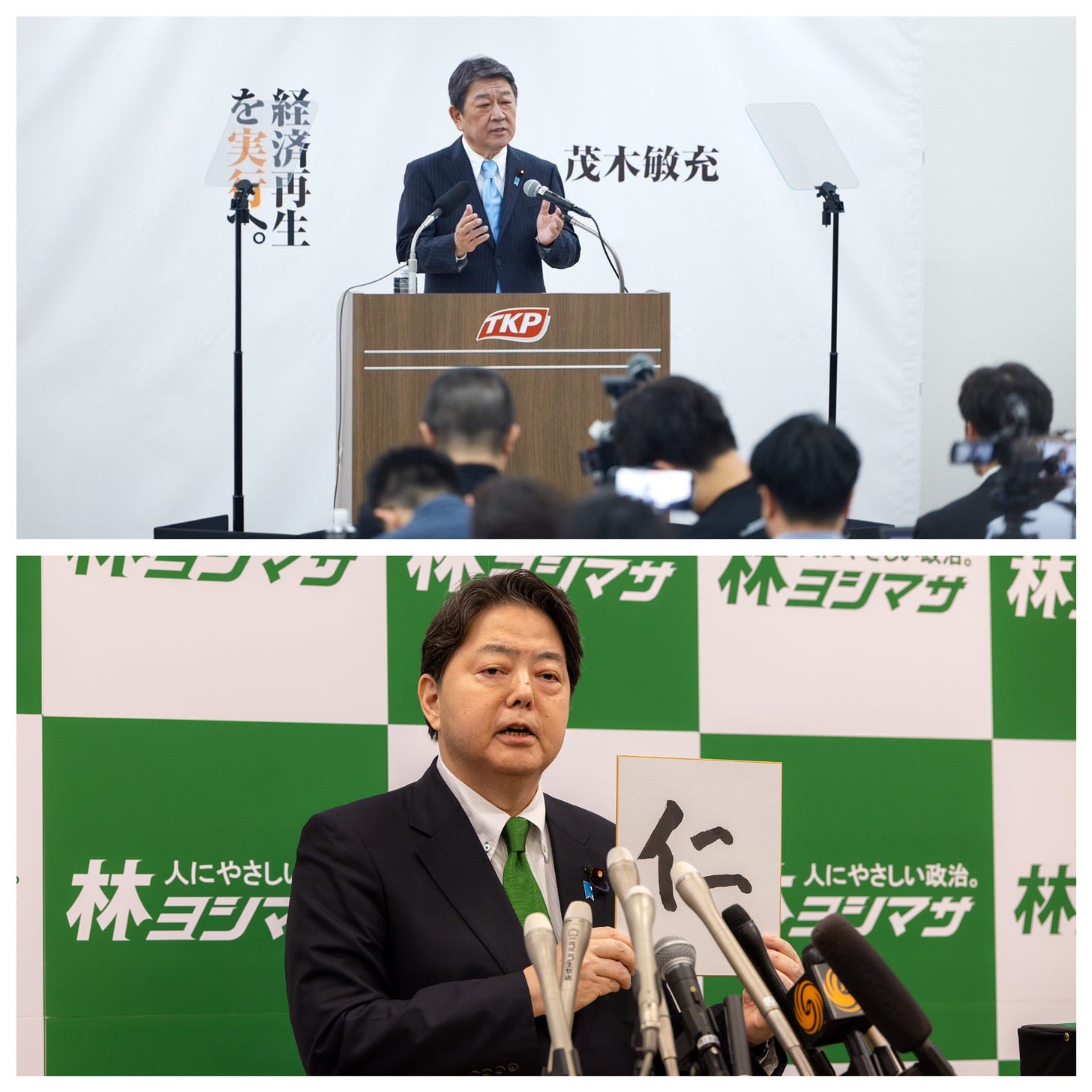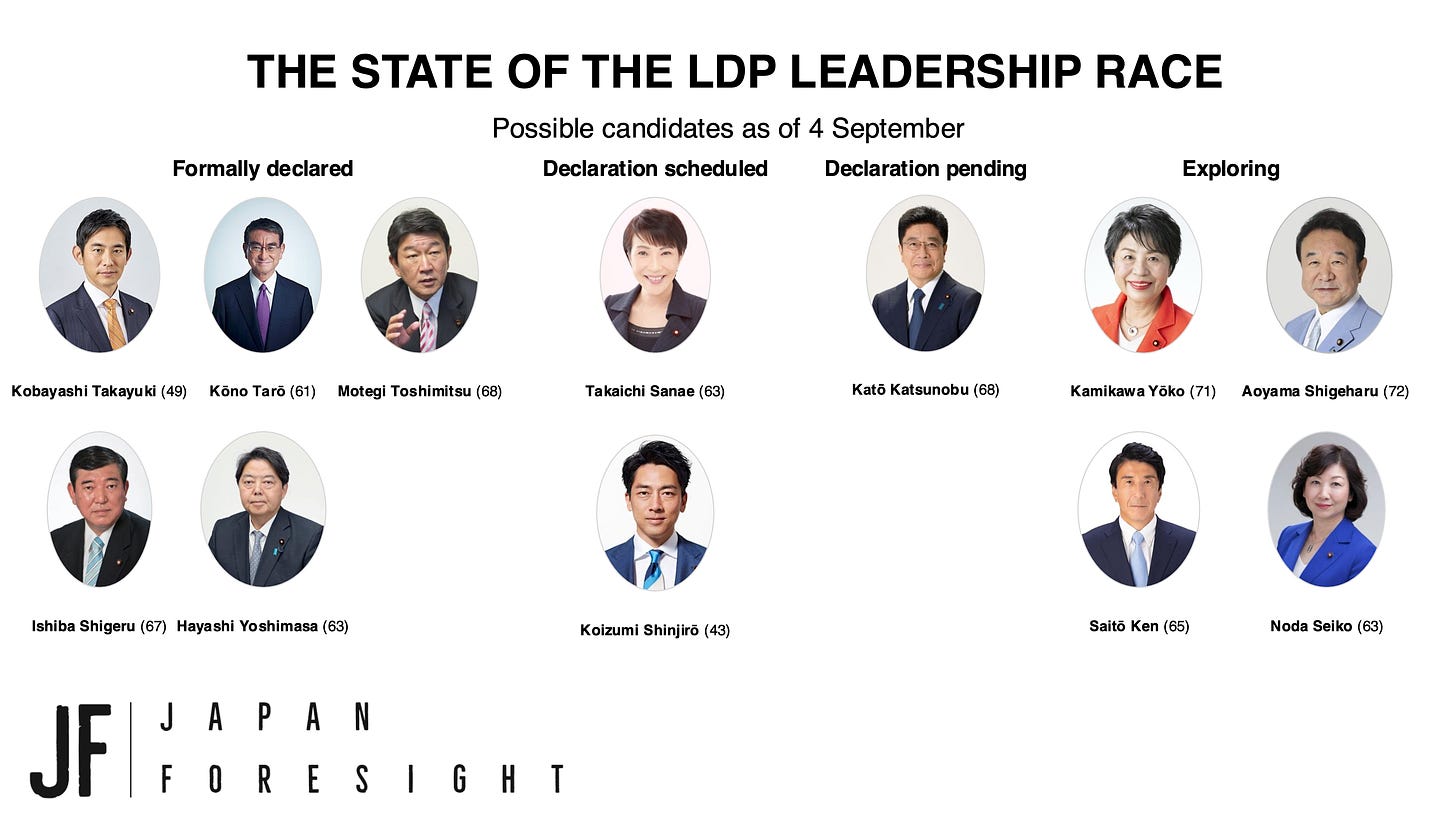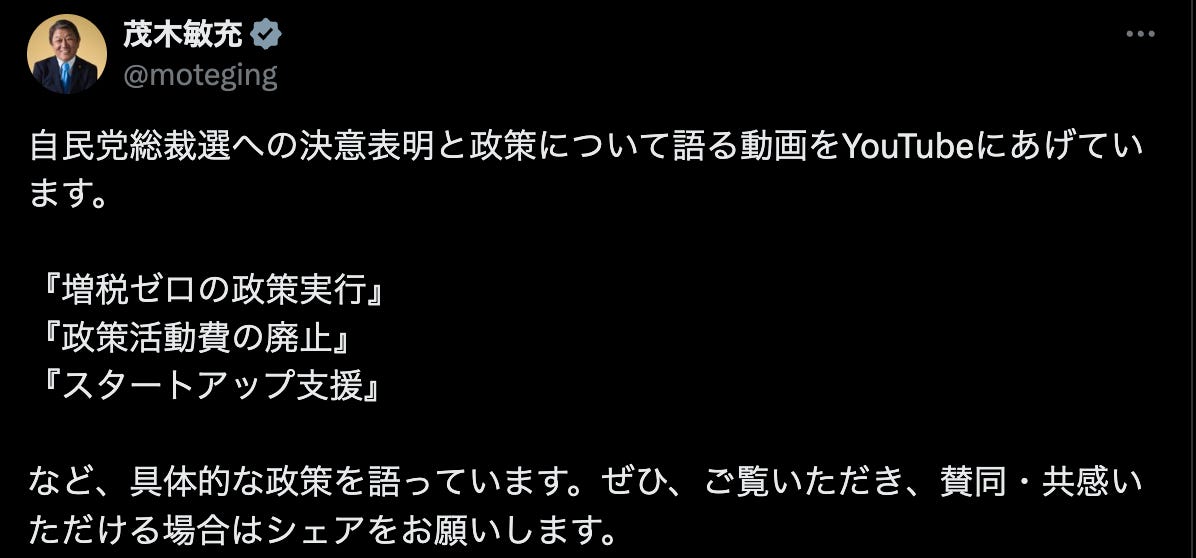The Experienced
Hayashi and Motegi enter the race, wishing for the triumph of experience over hope
Thank you for reading Observing Japan. This post is available to all readers.
If you are looking for timely, forward-looking analysis of the stories in Japans’s politics and policymaking that move markets, I have launched a new service through my business, Japan Foresight LLC. For more information about Japan Foresight’s services or for information on how to sign up for a trial or schedule a briefing, please visit our website or reach out to me.

The Liberal Democratic Party’s (LDP) leadership race gained two new candidates this week, when Chief Cabinet Secretary Hayashi Yoshimasa on 3 September and LDP Secretary-General Motegi Toshimitsu on 4 September formally launched their bids for the party presidency and the premiership.
It is not altogether surprising that both the second-ranking government and LDP officials would enter the race. Both have distinguished careers, with some of the lengthiest resumes in the field.
Hayashi, in addition to serving as chief cabinet secretary and foreign minister in the Kishida government, headed the Ministry of Agriculture, Forestry, and Fisheries (MAFF) and Education twice as well as the Ministry of Science, and Technology (MEXT) during the second Abe administration. He also stepped in to lead the Ministry of Defense briefly under Fukuda Yasuo in 2008 and wield the Economic and Fiscal Policy portfolio at the end of Asō Tarō’s government in 2009, contributing to a sobriquet used by the Sankei Shimbun, “the political world’s pinch hitter.” The son of a lower house member from Yamaguchi prefecture and a graduate of the Harvard Kennedy School of public policy, Hayashi served twenty-six years in the House of Councillors before finally winning a House of Representatives seat in 2021. His experience and policy expertise – as well as his 19 January birthdate – have also earned him the nickname of “Nagatacho’s 119,” referring to Japan’s emergency telephone number.
Motegi, meanwhile, was first elected to the House of Representatives in 1993 – part of the same class as Abe Shinzō – following a career that took him from trading company Marubeni to the Kennedy School to McKinsey before entering politics. Motegi probably has the lengthiest resume of any candidate in the LDP field. He has served in three top LDP jobs, including secretary-general (2021 onwards), policy affairs chief (2011-2012 and 2016-2017), and election strategy chief (2014-2016). He has held two, arguably three, top-tier cabinet posts, including foreign minister (2019-2021), minister of economy, trade, and industry (2012-2014), and Abe’s third minister for economic revitalization (2017-2019), whose portfolio included trade talks with the Trump administration. He was also a state minister with various portfolios in the Koizumi, Fukuda, and second Abe administrations. He was also, of course, the last head of the Heisei Kenkyūkai, the LDP faction that traces its lineage back to Takeshita Noboru and Tanaka Kakuei.
In normal circumstances, both Hayashi and Motegi would be formidable presences in an LDP leadership race, not least with Motegi as the head of one large, venerable faction and Hayashi as a deputy in another. These are not normal circumstances, however.
Instead, both candidates enter the race with extremely long odds of surviving to the runoff, let alone becoming Japan’s next prime minister. Without the factions playing a gatekeeping role or whipping their members’ votes, neither enters the race with a particularly significant number of lawmakers beyond their twenty endorsers. But, more importantly, in a race in which rank-and-file voters will play a larger role in the first round due a relatively smaller number of undecided lawmakers, neither has attracted much public support as they have weighed their candidacies. In the latest polls, Motegi polled between 1% and 2% and Hayashi between 0% and 1% with LDP supporters, a gap with the top candidates that will be virtually impossible to close.
In a race that has already been shaped by perceptions that voters are looking for bolder leadership that marks a departure from the Kishida government, it may be too difficult for Hayashi and Motegi – two of the most prominent figures under Prime Minister Kishida Fumio – to run as change candidates. Hayashi, in particular, as a member of Kishida’s faction and one of the prime minister’s main lieutenants, may especially struggle in this climate, since he has little choice but to present himself as a continuity candidate. Motegi, who appeared ready to campaign directly against Kishida, may be less constrained from breaking with the prime minister, but as the LDP’s leading official when the kickback scandal emerged, it may be difficult for him to present the “clean” image that voters may prefer, notwithstanding Motegi’s pledge on Wednesday to create a “new LDP.”1
Both have other liabilities that will limit their appeal within the parliamentary party. Hayashi is disliked by the right wing, not least because he is perceived as soft on China; the chief cabinet secretary tried to preempt this criticism in his press conference Tuesday when he referred to himself as a strategically valuable “China knower” rather than a “China flatterer.” Motegi, meanwhile, has a reputation for being tough to work for, with numerous stories of his “power harassment” in circulation, suggesting that he has not necessarily endeared himself to his colleagues.2 The exodus of senior members of his faction earlier this year suggested a certain lack of confidence in Motegi from the lawmakers who knew him best.
Despite these liabilities, in a fluid race it is difficult to rule out either candidate. Both have made clear that they will lean on their expertise and experience to draw a contrast with some of the more popular candidates in the race, gambling that as the LDP’s rank-and-file voters approach their decision, they may opt for veteran leadership after all. Motegi, in particular, will stress his ability to manage the US-Japan relationship in the event that Donald Trump wins a second presidential term in November, an argument he began making over the summer and made again in his press conference on Wednesday. In general, Motegi is clearly trying to position himself as an Abe-like leader who will assemble a team that gets things done (and even gestured in a right-wing direction with his decisive rejection of Kishida’s plan to raise taxes to pay for defense spending increases).3
But experience will be no guarantee of success. With two national elections looming in the next year, the LDP’s electors – both lawmakers and rank-and-file voters – may be ready for a more decisive break with the past than either Hayashi or Motegi can offer. They have just over three weeks to convince their party that their experience is what the moment requires.
Before Kishida dropped out, Motegi was being referred to as the “Akechi Mitsuhide of the Reiwa era,” referring to treacherous retainer who forced Oda Nobunaga to commit seppuku in 1582.
Motegi’s campaign slogans are strongly reminiscent of Abe. 「経済再生を実行」— keizai saisei wo jikkō — the slogan Motegi used as his backdrop on Wednesday might as well have been one of Abe’s slogans. Meanwhile, the three slogans Motegi uses in his tweet — implement policies with no tax hikes, abolish policy activity funds, and support start-ups — resemble Abe in both style and substance.





